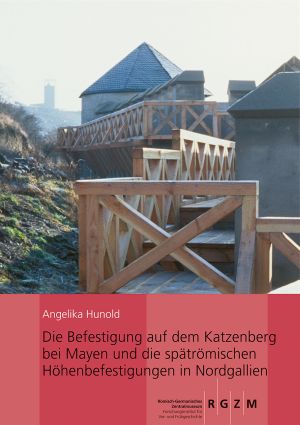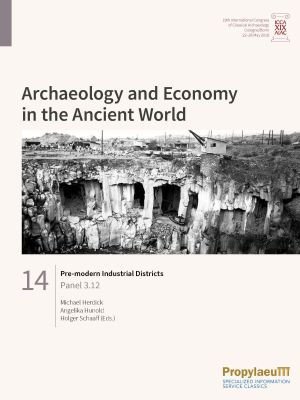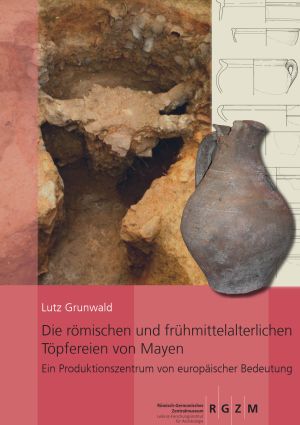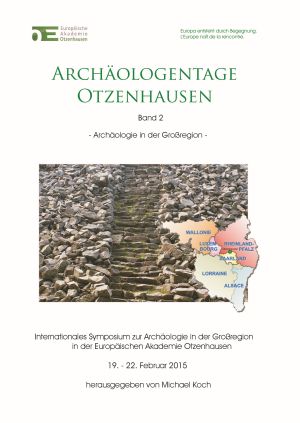Hunold, Angelika
Die Befestigung auf dem Katzenberg bei Mayen und die spätrömischen Höhenbefestigungen in Nordgallien
Auf dem Katzenberg bei Mayen bestand von etwa 300 n. Chr. bis in die Mitte des 5. Jahrhunderts zum Schutz des Wirtschaftszentrums Mayen eine militärische Befestigung, die zu den größten ihrer Art gehört.
Ausgehend von den dort gewonnenen Ergebnissen werden 143 weitere Höhenbefestigungen in Nordgallien untersucht. An Verkehrswegen orientiert, vor allem an den Wasserstraßen, besitzen diese Anlagen keineswegs den Charakter versteckter Refugien. Vielmehr können auch sie als Militäranlagen eingestuft werden, die in ein übergreifendes Verteidigungskonzept eingebunden waren. Sie sicherten den Fortbestand des zivilen und wirtschaftlichen Lebens im ländlichen Raum. Somit bilden Höhenbefestigungen eines der Elemente einer tief gestaffelten militärischen Sicherung in der Spätantike.
Pre-modern Industrial Districts: Panel 3.12
Das antike Steinbruch- und Bergwerksrevier der Osteifel wird seit 1997 vom Römisch-Germanischen Zentralmuseum (RGZM) in Mainz und Mayen erforscht. Die Produkte – allen voran Mühlsteine aus Basaltlava, Baumaterial aus Tuffstein und Keramikgeschirr – wurden viele Jahrhunderte lang in weite Teile Europas exportiert.
Um dieses reichhaltige Bodenarchiv zur antiken Steinindustrie zu untersuchen und deren Rolle bei der römischen Okkupation und der Romanisierung nördlich der Alpen zu definieren, wurde ein umfangreiches Forschungsprogramm initiiert. Wesentliche Themen waren die Basalt- und Tuffsteinindustrie sowie das Wirtschaftszentrum Mayen. Die Keramikindustrie wird aus der Perspektive archäologischer Materialstudien, aber auch durch die experimentelle Archäologie untersucht. Weitere Studien widmeten sich den Voraussetzungen, unter denen sich der wirtschaftliche Aufschwung vollzog, insbesondere der Infrastruktur und der ländlichen Besiedlung.
Als Industrierevier von überregionaler Bedeutung erwies sich das Steinbruch- und Bergwerksrevier der Osteifel als hervorragende Fallstudie für die Erforschung vormoderner Industriereviere allgemein und ermöglichte die Ableitung eines Modelles zur Untersuchung antiker Industrien. Von besonderer Bedeutung für ihr Verständnis sind die Langzeitperspektive und ein ganzheitlicher Ansatz, der ökonomische und soziale Aspekte sowie die Siedlungsentwicklung berücksichtigt.
Die römischen und frühmittelalterlichen Töpfereien von Mayen: Ein Produktionszentrum von europäischer Bedeutung
Die in Mayen hergestellte Mayener Ware gilt als charakteristisch und datierungsrelevant. Für Teile des antiken europäischen Wirtschaftsgefüges waren diese Keramikprodukte prägend. Die Mayener Töpfereien gehörten zum vormodernen Industrierevier zwischen Osteifel und Rhein. Hier erfolgte über das 5. Jahrhundert hinweg ein bruchloser Wissens- und Techniktransfer von der römischen Epoche in das Frühmittelalter. Die Studie geht über die typochronologische Beurteilung der Gefäßkeramik hinaus. Es werden auch Aspekte des individuellen Lebens der Töpfer in ihren vielschichtigen Lebenswelten wie ihre Glaubensvorstellungen, ihre Besitzabhängigkeiten oder die Geldwirtschaft angesprochen.
Römische Landnutzung im antiken Industrierevier der Osteifel
Seit Beginn der Römischen Kaiserzeit erlebte die Gegend zwischen Mayen am Rande der Eifel und Andernach am Rhein eine enorme Steigerung ihrer wirtschaftlichen Aktivität. In kurzer Zeit entstand dort ein Industrierevier, von dem aus weite Gebiete in den römischen Nordwestprovinzen mit hochwertigen Basaltlava-Mühlsteinen, leichten Tuffsteinen und später auch mit hitzebeständiger Keramik versorgt wurden. Steinbrüche wurden neu angelegt, Land- und Wasserwege ausgebaut, bestehende Absatzräume ausgedehnt und andere erst noch erschlossen. Auf Rückschläge im 3. und 4. Jahrhundert folgten weitere Boomphasen.
Wie konnten die zahlreichen Arbeiter und ihre Familien ernährt werden, und welche Folgen hatte der Erfolg der Stein- und der energieintensiven Keramikindustrie für die Umwelt? Um dies zu klären, wurden zwei römische Villen am Nordrand der Mayener Mühlsteinbrüche mit geophysikalischen Messungen, Grabungen, geoarchäologischen und botanischen Untersuchungen erforscht und ihr gesamtes Umfeld erkundet. Die Ergebnisse präsentiert dieses Buch. Die Bewohner der villa Mendig, »Im Winkel« waren selbst an der Herstellung von Mühlsteinen beteiligt. In der Spätantike dürfte eine Flächendrainage dort einen Umschlagplatz für Mühlsteine am Segbach trocken gehalten haben, während ein wehrhafter Speicherbau die Versorgung der Steinbrucharbeiter sicherstellte. In der villa Mendig, »Lungenkärchen« residierten Steinbruchbesitzer. Sie erwies sich als Axialhofanlage mit imposantem Wasserbecken. Begehungen führten ebenso zur Auffindung des zu »Lungenkärchen« gehörenden Begräbnisplatzes mit Monumenten aus Lothringer Kalkstein wie zur Entdeckung eines bislang unbekannten vicus »Im Terl«.
Archäologie in der Großregion: Beiträge des internationalen Symposiums zur Archäologie in der Großregion in der Europäischen Akademie Otzenhausen vom 19. - 22. Februar 2015
Der vorliegende Tagungsband dokumentiert die Vorträge und Präsentationen der 2. Archäologentage Otzenhausen und macht sie damit auch denjenigen zugänglich, die nicht an den Archäologentagen teilnehmen konnten. Die ungezählten Gespräche und „Grenzüberschreitungen“ am Rande und in den Pausen, an den Abenden und bei den Exkursionen lassen sich nicht dokumentieren. Und doch machen gerade sie den besonderen Reiz der Archäologentage Otzenhausen aus.











